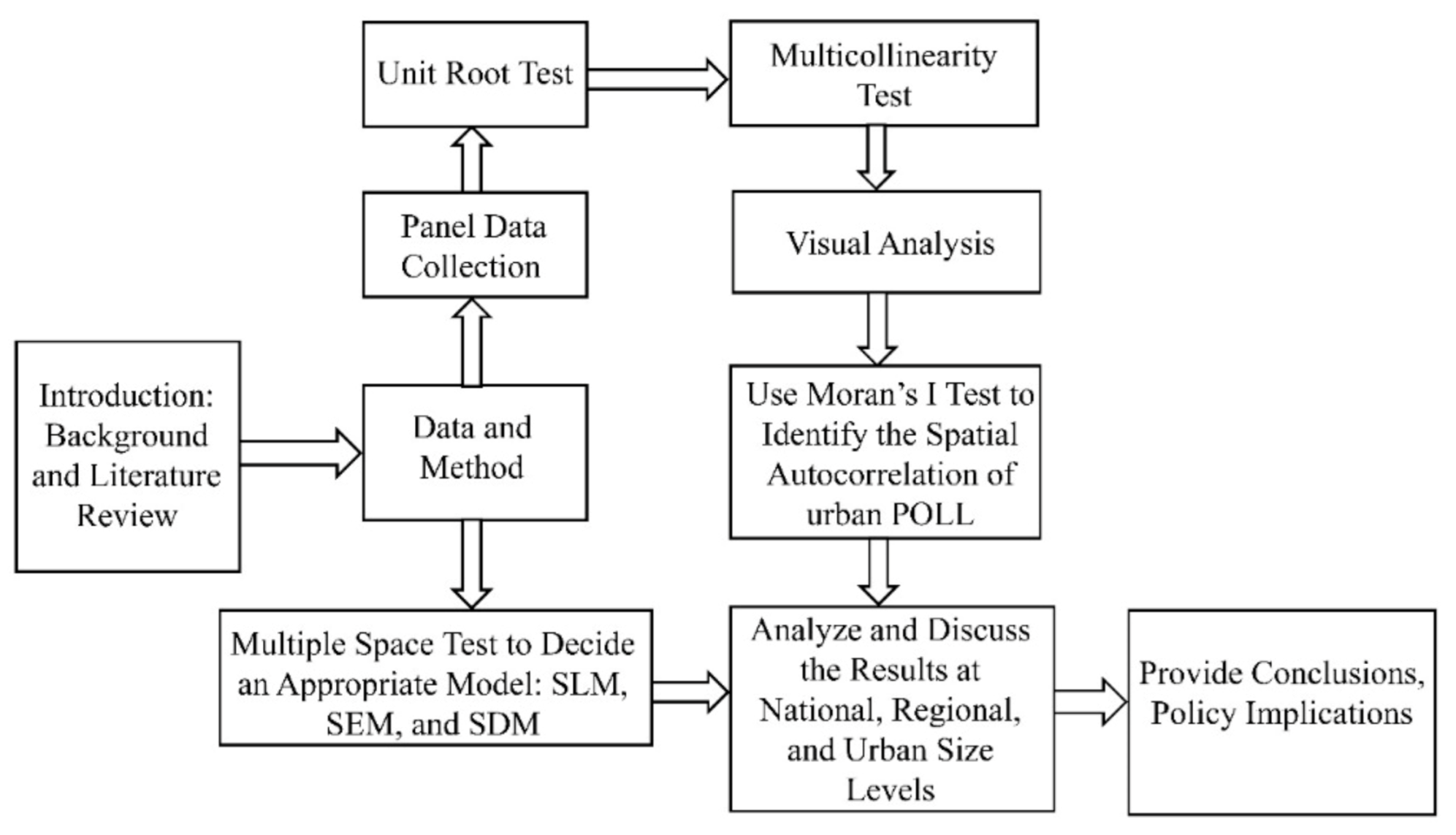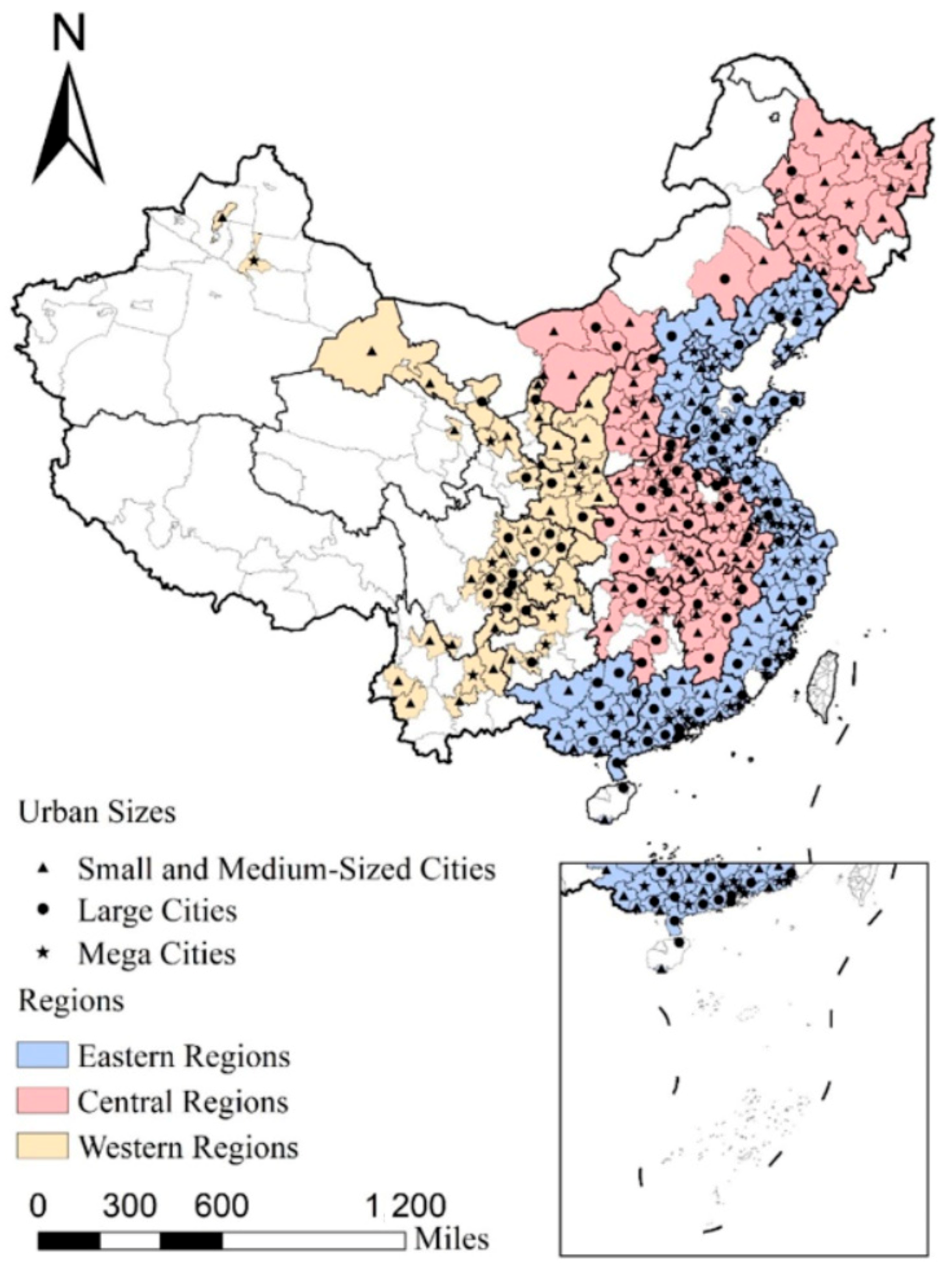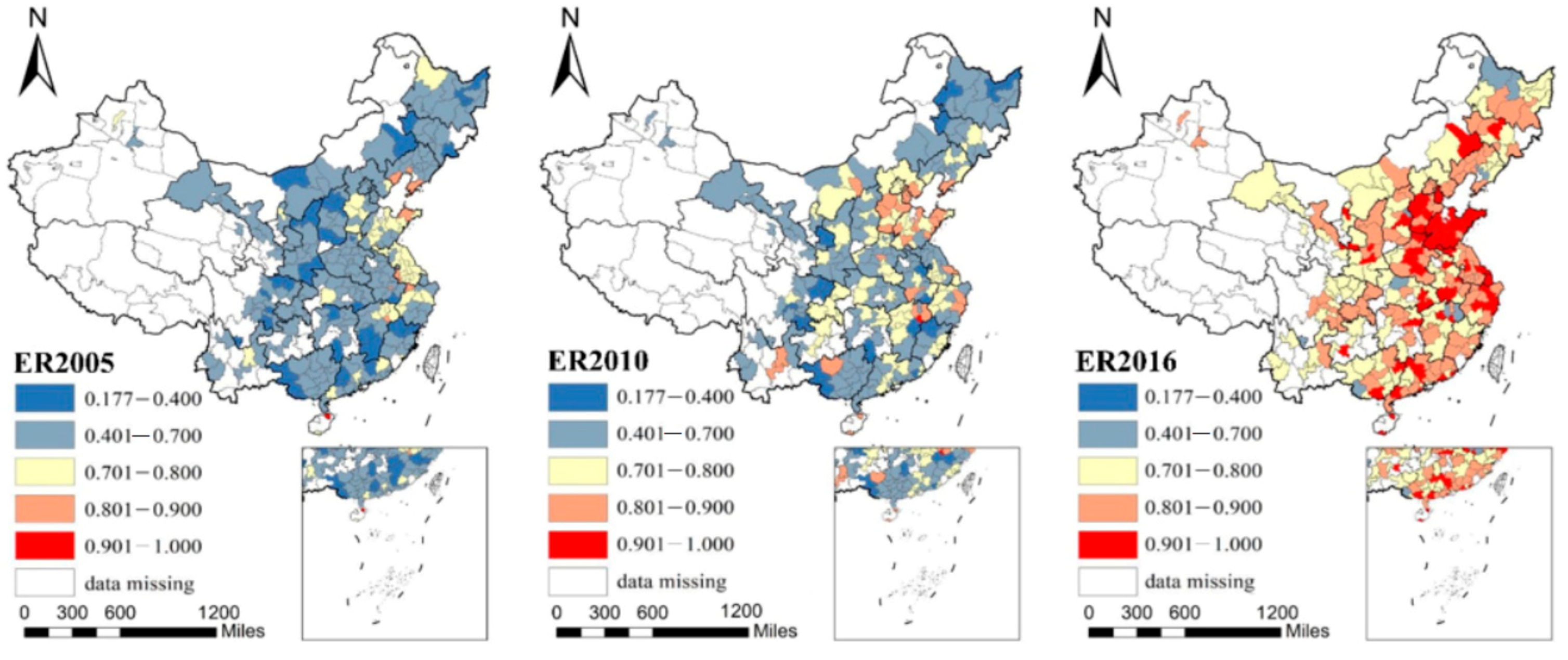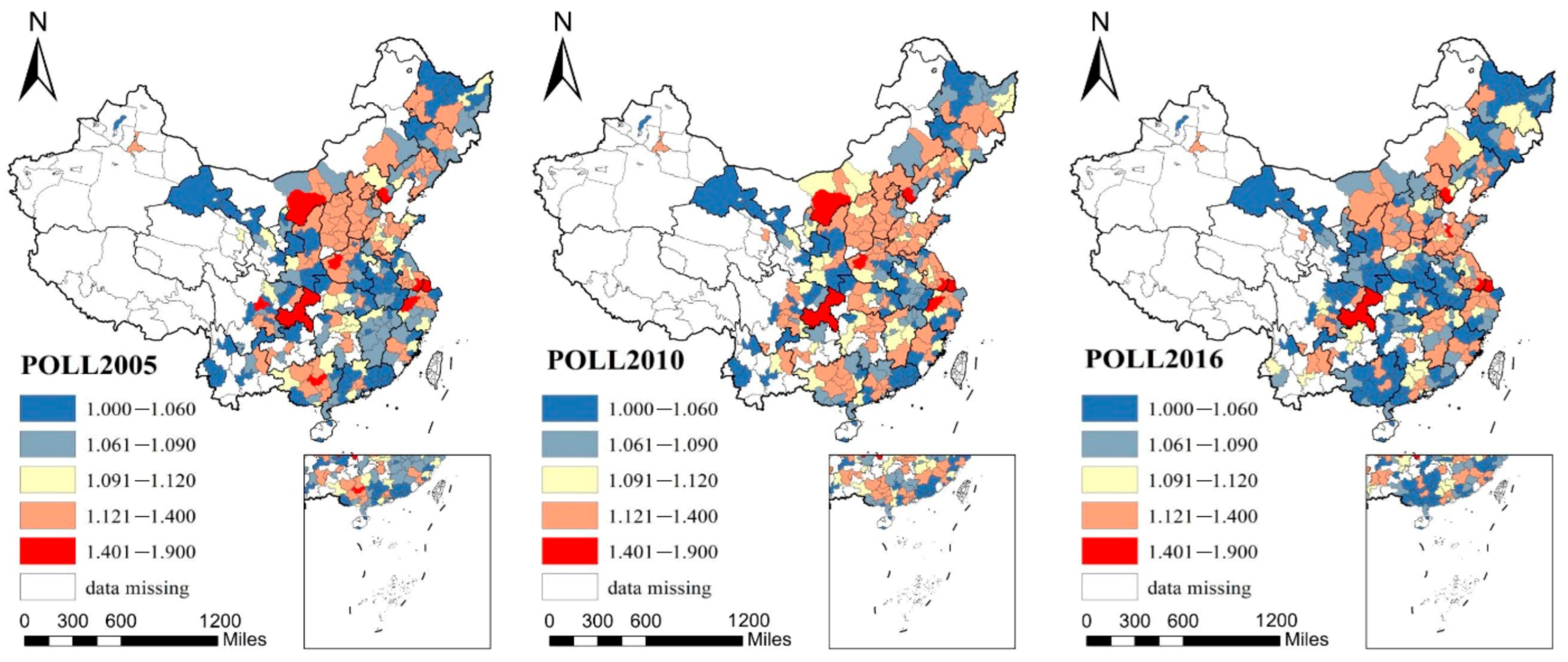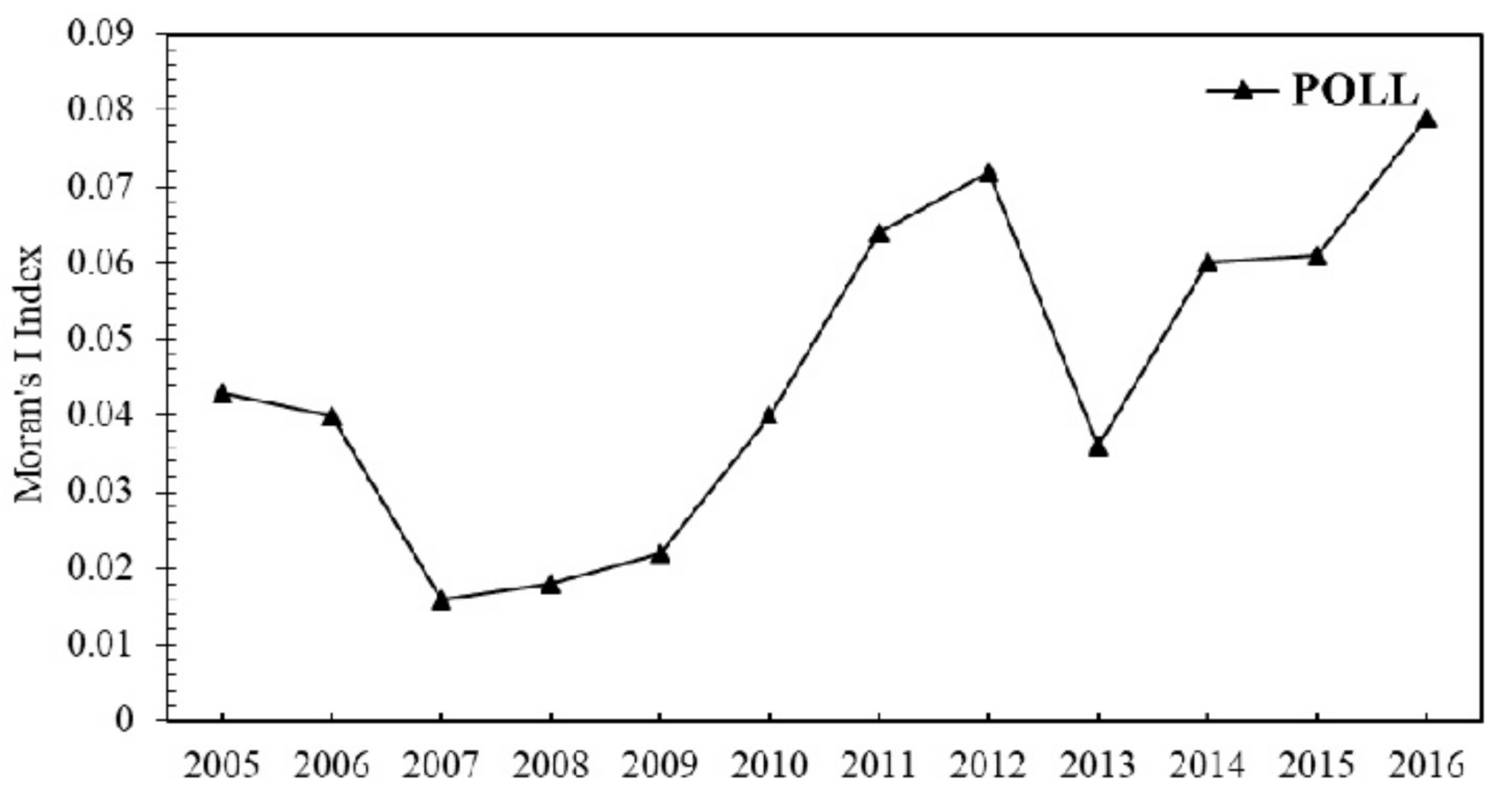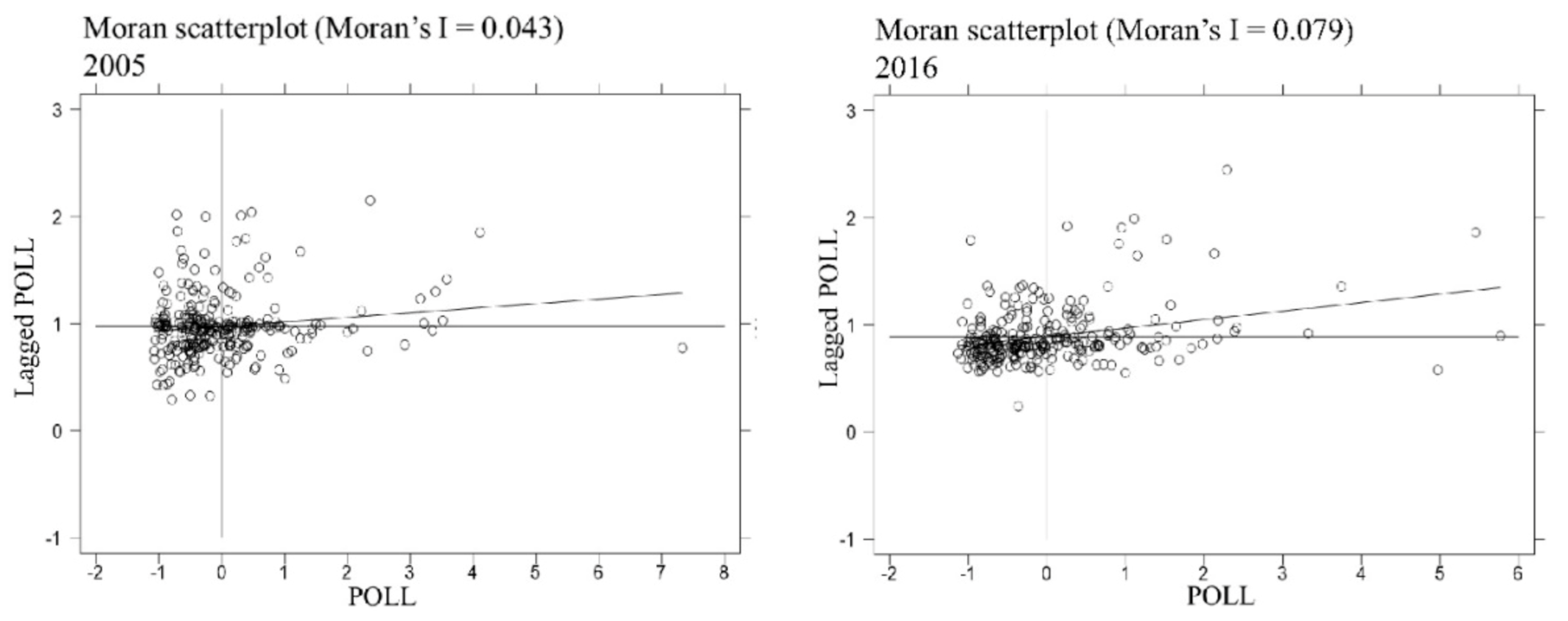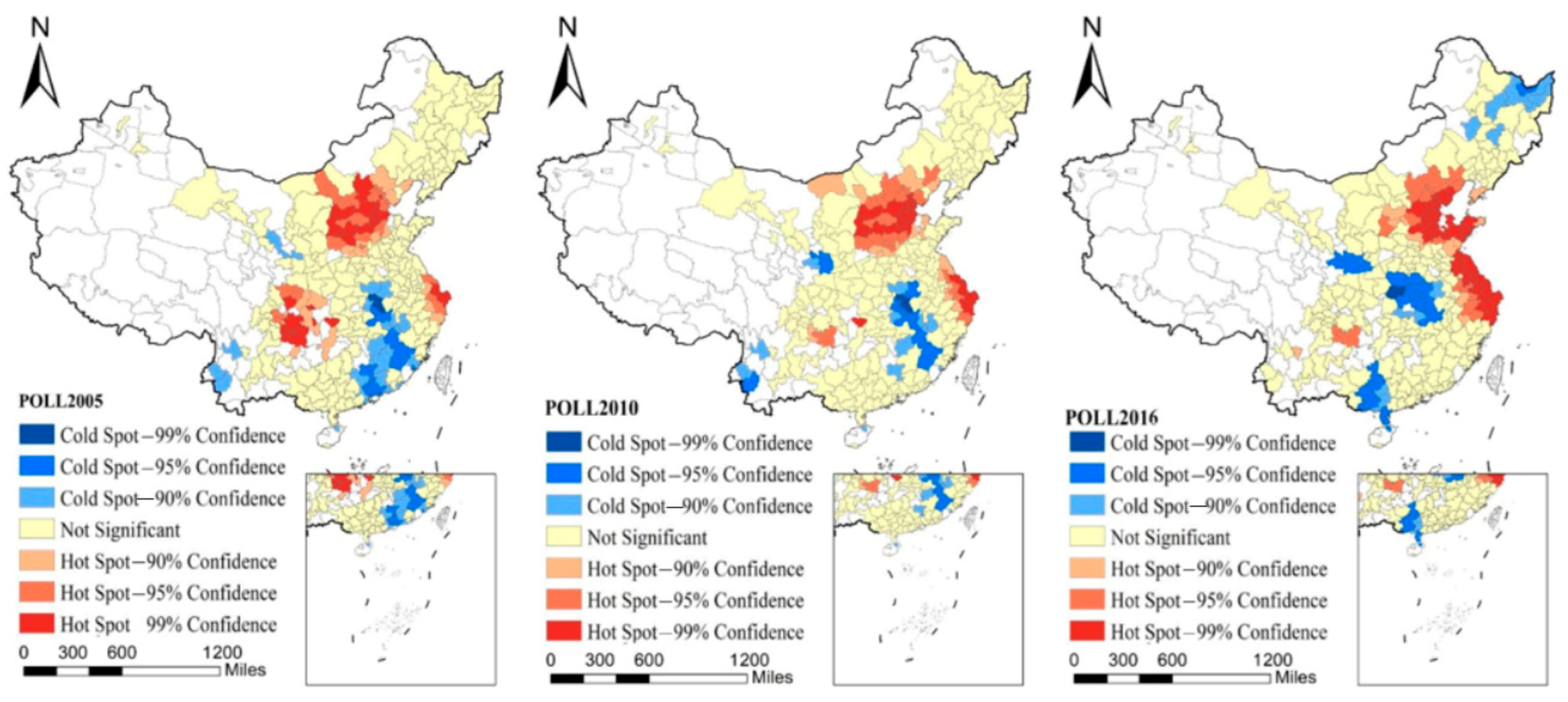5.3. Analysis of Regression Results for National Sample
The model applicability test is conducted to find a suitable spatial econometric model (i.e., SDM, SLM, and SEM). The test results in
Table 4 reflect that both LM and Robust LM are positive at the 1% significance level, indicating that there is a spatial effect in urban POLL. Meanwhile, the results of LR and Wald test are also significant at the level of 1%, denoting that SDM should be selected. Moreover, the results of Hausman test represent that the fixed effect should also be chosen for regression estimation. Therefore, this research finally used the SDM under the fixed effects of time and space to empirically investigate the effects of ER, PRO and their interaction terms on urban POLL. The estimation results of SDM under the inverse distance spatial weight matrix at the national level are reported in
Table 5.
First, the direct effects of core variables are as follows. (1) The direct effect of ER on urban POLL is negative, representing that the implementation of ER has reduced the urban POLL during the research period. In order to achieve the coordinated development goal of urban economic growth and environmental protection, the Chinese government has formulated and implemented a series of environmental policies. The State Council issued the “11th Five-Year Plan for National Environmental Protection” and the “12th Five-Year Plan for National Environmental Protection” in 2007 and 2011, respectively, requiring the reduction of urban POLL. Therefore, local governments have adopted a series of strict environmental supervision measures for industrial areas with serious pollution. With the gradual strengthening of urban ER, the proportion of pollution control costs in the total cost of enterprises has gradually increased, which has severely weakened corporate profits. This has forced companies to improve production technology, eliminate high-pollution and high-energy-consuming industries, and develop low-pollution, low-energy-consuming industries, thereby effectively improving the quality of the urban environment. (2) The direct effect of PRO on POLL is negative, which shows that the PRO in the local cities can promote the improvement of local urban environmental quality. In recent years, the central government has stressed the importance of energy conservation and environmental protection in the process of economic development, in the context of a scientific outlook on development-oriented cadre evaluation system. The central government clearly proposed the assessment of officials’ environmental performance as one of the criteria for their appointment and promotion in 2005. The Ministry of Environmental Protection of China proposed the environmental governance accountability system and implemented “one vote no customization” for local officials in 2007. The “one vote no customization” means that the assessment results of environmental governance will be directly linked to the officials’ performance. Those officials who fail to complete the tasks of energy conservation and emission reduction will be held accountable. The central government has incorporated environmental governance into the performance evaluation system of local officials for local officials, prompting local officials to have more motivation to pay attention to environmental protection. For example, Huzhou City, Hangzhou City, and Lishui City have replaced the original GDP assessment with ecological protection and improvement of people’s livelihood. In order to achieve the performance evaluation goals of environmental protection, local officials who are promoted have more motivation to improve the quality of the urban environment and achieve new environmental governance goals. (3) The direct effect of the interaction between ER and PRO on POLL is negative in the national sample, which reflects that the PRO in the local cities has promoted the improvement of local environmental quality by strengthening ER in the local cities. On the one hand, the promotion of officials has encouraged local governments to increase the intensity of environmental regulations and accelerate the elimination of backward production capacity. Companies that fail to meet environmental technical standards will face the risk of closure or bankruptcy, which forces companies to improve green production levels and reduce urban environmental pollution. On the other hand, the promotion of officials has increased the environmental protection and technical skills of local investment promotion, and has triggered competition for talents among local governments. By vigorously developing strategic emerging industries and high-tech industries, the optimization and upgrading of the industrial structure will be promoted, and the improvement of urban environmental quality will be promoted.
Second, the indirect effects of core independent variables are as follows. (1) The indirect effect of ER on POLL is positive. Free riding does not exist in environmental regulation in the national sample. The spatial dependence of environmental regulation reduces the effectiveness of local environmental regulation. The industrial transfer caused by the difference level of environmental regulation can only reduce the pollution level of the moving-out area. By contrast, stricter environmental regulations in surrounding areas will aggravate air pollution in local area. It will have very limited impacts on improving the environmental quality. Therefore, local governments in urban agglomerations should propose more stringent environmental regulation and strengthen the joint prevention and control of air pollution at the regional level. (2) The indirect effect of PRO on POLL is negative, that is, increasing the official promotion in adjacent cities can reduce POLL in local cities. (3) The indirect effect of the interaction between ER and PRO on POLL is negative. The PRO in the adjacent cities has promoted the improvement of local environmental quality by strengthening ER in the adjacent cities.
Third, the direct effects of control variables are as follows. (1) The direct effect of PGDP on POLL is positive. The reason is that rapid development of China’s economy is at the cost of a large amount of fossil energy consumption and urban POLL. Therefore, it is necessary to promote the transformation of economic growth mode from extensive and resource-based to efficient and innovative. (2) The direct effect of IS on POLL is negative, indicating that with the development of tertiary industry and clean technology, the optimization and upgrading of the industrial structure has positive effects on pollution control. Therefore, strengthening the technological progress of the industrial sector, encouraging the development of the tertiary industry and promoting the upgrading of the industrial structure are of great significance to reducing urban POLL in China. (3) The direct effect of POP on POLL is positive, which indicates that the increase of urban population size has hindered the improvement of urban environmental quality in China. The increase in urban population size has led to urban POLL through production channels and energy consumption. (4) The direct effect of FDI on POLL is positive. Due to loose regulation, developed countries with a high degree of environmental regulation tend to transfer pollution-intensive industries to countries with a low degree of environmental regulation, thus aggravating environmental pollution. Hence, when introducing FDI, local government should not only pay attention to the economic benefits, but also set a stringent threshold of environmental impacts.
Last but not least, the indirect effects of control variables are as follows. (1) The indirect effect of PGDP on POLL is positive. The reason is that the economic growth in adjacent cities has reduced the POLL in local cities. In other words, economic growth has positive spatial spillover effects in China. The reason is that the economic competition of the governments in adjacent cities has promoted the expansion of the production scale of local cities, which has caused POLL in local cities. (2) The indirect effect of IS on POLL is positive, implying that the improvement of industrial structure in surrounding cities has increased the POLL of local cities, which shows that the transfer of high-polluting industries from adjacent cities to local cities has increased POLL of local cities.
5.4. Analysis of Region-Scale Regression Results
China has a vast territory, and there are regional differences in economic growth and natural environment. This paper divides 266 prefecture-level cities into three geographic regions to investigate the spatial imbalance at the regional level: eastern China, central China and western China. Specifically, there are 112 cities in the eastern China, 102 cities in the central China and 52 cities in the western China. Based on the regression analysis of POLL in different regional levels, the results are shown in
Table 6.
The effects of ER, PRO, and their interaction terms on urban POLL are different at the different region levels. For the core variables, the direct and indirect effects of the interaction between ER and PRO on POLL are negative in the western region. Furthermore, the direct effect of ER on POLL is negative in the eastern and central regions. The ER in neighboring cities promotes POLL of local cities in the western region. The direct and indirect effects of PRO on POLL are negative in the western region.
For the control variables, the direct and indirect effects of PGDP on POLL in the eastern regions are positive, implying that economic growth can promote urban POLL. The indirect effect of PGDP is positive on POLL in the central region, which indicates that greater per capita GDP of adjacent cities can bring along POLL of local cities in the central region. From the perspective of direct effect, POP among different regions can promote POLL. From the perspective of indirect effects, population size of adjacent cities has a positive impact on POLL of local cities in the eastern region. The direct effect of IS indicates that the more developed tertiary industry of local cities can reduce POLL. The direct effect of FDI on POLL in the eastern and western regions is positive. From the perspective of indirect effects, FDI of adjacent cities can reduce POLL of local cities in the eastern region, whereas the effect is opposite in the western region.
5.5. Analysis of City-Scale Regression Results
The population at the end of the year was selected to represent the urban sizes to investigate the effects of ER, PRO, and their interaction terms on urban POLL. According to the urban population at the end of 2016 in China, the urban sizes can be divided into three categories: mega cities with more than two million urban population, large cities with one million to two million urban population, and small and medium-sized cities with less than one million urban population. Specifically, there are 60 mega cities, 90 large cities and 116 small and medium-sized cities. Based on the regression analysis of POLL in different urban sizes, the results are shown in
Table 7.
The impacts of ER, PRO, and their interaction terms on urban POLL are different among different urban sizes. For the core variables, the direct effect of the interaction between ER and PRO on POLL in small and medium-sized cities is negative. From the perspective of indirect effects, the interaction between ER and PRO of adjacent cities in small and medium-sized cities and mega cities has no impact on POLL of local cities, whereas it is conducive to reducing POLL of local cities in large cities. In addition, the direct impact of ER on POLL is negative in mega cities. The indirect effect of ER on POLL is positive in large cities, and the indirect effect of ER on POLL in megacities is negative in megacities. The direct and indirect effects of PRO on POLL are negative in small and medium-sized cities and large cities.
For the control variables, the direct effect of PGDP on POLL is positive in small and medium-sized cities and mega cities, while it is negative in large cities. The direct effect of POP on POLL is positive among different urban sizes, which indicates that the local urban population plays an important role in the increase of urban POLL. The direct effect of IS indicates that the adjustment and improvement of industrial structure in local cities can reduce POLL. Regarding the indirect effect, the IS of adjacent cities can reduce POLL of local cities in the large and mega cities. The POP of adjacent cities can promote POLL of local cities in large and mega cities. The direct effect of FDI can promote POLL in small and medium-sized cities, while the opposite effect is observed in mega cities.
